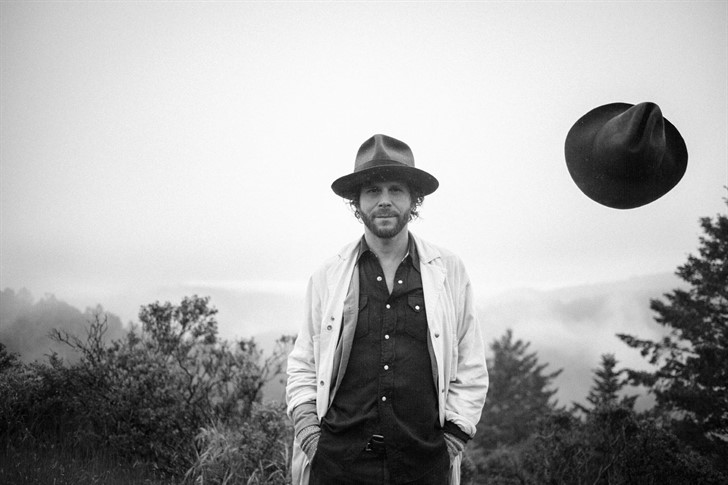Spotlight: Langhorne Slim
 Harvey Robinson
Harvey Robinson
On a Wednesday night in Nashville, Langhorne Slim is rushing out the door to see the symphony for the very first time—and he plans to look his best.
“I’d been looking for a good suit, one that fits and feels right,” he says. “I found it in my buddy’s vintage shop down in New Orleans—brown, beautiful pinstripes. I’ve been wearing it almost daily since I bought it.”
It’s surprising, but also quite endearing, to hear the 37-year- old singer, born Sean Scolnick, talk about appearances with such enthusiasm. In his music, he speaks unapologetically about stripping off our society-forged masks, about destroying our egos, about digging into our true selves. And on his latest album, the excellent Lost at Last, Vol. 1, he presents himself as rawer than ever before.
“What guided me [on this album] was the concept of getting out of my own head, to allow myself to be a vessel for melody and words. I wasn’t analytical. I allowed myself
So what does that purity sound like when laid down in the studio? Lost at Last, Vol. 1 plays as a warmer, gentler, scrappier companion to Slim’s critically adored breakthrough, The Spirit Moves, from 2015. The album was born on the hood of a rental car parked outside the Newport Folk Festival in 2016—Slim had just watched Patti Smith’s set, and he was floored.
“It was the most guttural, real, punk-rock thing I’d seen. I was transported to another place. And I sat on the hood of my rental and started to cry,” he remembers. His friend Dan Kasin stepped into his bubble of public vulnerability, and they began talking music. Kasin also mentioned the new, remote Panoramic House studio in Stinson Beach, Calif., which boasts picturesque views of the Pacific Ocean and loads of analog equipment; it seemed like the perfect fit for the vision Slim had already started to shape.
He started honing in a on new batch of songs that explored old folk tropes—the search for truth, meditations on love, a contemplative look at loneliness—and they called for a real, live delivery.
“My favorite lyricists are often saying something that’s simple, or has been said before, but in a way you haven’t heard—and it wakes your ass up. So since I’d put out The Spirit Moves, I knew I wanted to create something as raw as possible, folky tunes that I taught the guys and they just played along with me—not road-tested material,” he says.
Slim rehearsed his new collection of tunes in San Francisco with members of his band, The Law, for five days before camping out in Stinson Beach, “Living together, cooking with each other and creating this thing with each other,” he says. “They’re songs that I write, but I wanted to live and breathe them with these people, not clock in and out to make a record.”
The songs came fast and focused over 10 days on the coast, laid down with a warmth and looseness that paint pictures of late-night sessions, red-orange sunsets and raucous family dinners. Some tunes are soberingly frank; the hushed, fast-picked “Life Is Confusing” finds Slim meditating on ever-elusive stillness: “Can we be happy
for a while?/ Can we just sit here, shut up and smile?/ Been talking for hours, forgot what we’re saying/ Life is confusing and people are insane.”
Later, on the bluesy dirge “Alligator Girl,” he’s howling over far-off, barroom piano and dusty, stand-up bass runs: “I jumped in the river/ Swam to the bar/ Hoping to be delivered/ Away from the clap of thunder/ Throw the covers from my face/ Lift my head off my pillow/ Check the darkness just in case she wakes.”
Recording live to tape inspired a sense of urgency in the band, even as the songs came out as impromptu boot-stomp singalongs. “With tape, the band’s got to be ready for the cut,” says Slim. “It elevates everybody’s mood to be in it all together. It unifies you in a way that captures this raw feeling. That Ray Charles shit, that Louie Armstrong shit—all recorded in one room, and it sounds incredible.”
Slim flew to New Orleans, Los Angeles and New York to add horns and, admittedly, overdub a few parts, but the finished Lost at Last, Vol. 1, still comes off as a live-in-the-living-room type of old-time folk record—playful and spacious, gently grooving and bouncing, as alive and truthful as Slim had imagined it. And while the album doesn’t include any overt calls to go out and find your own truth, it’s vulnerable, bare music that Slim hopes will inspire the same introspection in fans—haters be damned.
“In our culture, looking within, feeling vulnerable or sensitive, seeking a more profound or open, spiritual lifestyle—why is that somehow seen as liberal, hippie bullshit?” he asks. “These concepts didn’t start in 1968. This is ancient. I know connecting with ourselves and our universe is not for everyone. I just know the more I reveal, the freer I feel. When I open myself up, I want to let it rip.”
He pauses, and an energy pulses through the phone.
“Look, we all feel like fucking freaks out here. We all deal with great joys and strengths and major fears,” he says. “But at this point, I feel like there’s nothing to hide. The wizard behind the curtain? Fuck that curtain already.”
This article originally appeared in the January/February 2018 issue of Relix. For more features, interviews, album reviews and more, subscribe here.



















